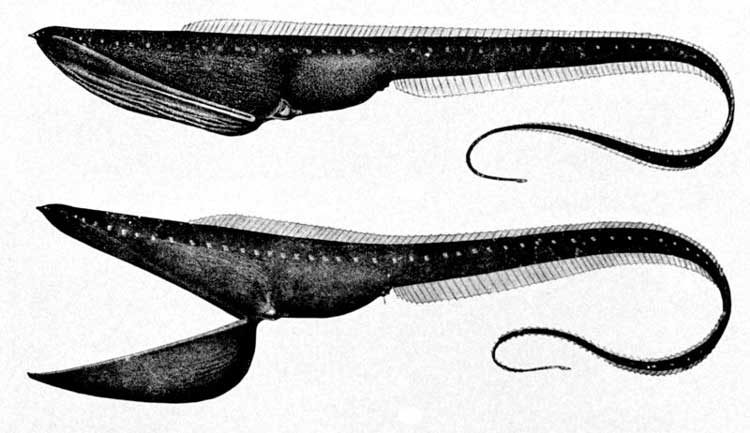Eurypharynx pelecanoides Cladus: Eukaryota The pelican eel, or Eurypharynx pelecanoides, is a deep-sea fish rarely seen by humans, though the creatures are occasionally snagged in fishermen's nets. It is an eel-like fish, the only member of the genus Eurypharynx and the family Eurypharyngidae. It belongs to the order Saccopharyngiformes which is closely related to the true eels in Anguilliformes. It is also sometimes referred to as the umbrella mouth gulper. The fish is also known with the alternative scientific names Gastrostomus pacificus, Macropharynx longicaudatus, Gastrostomus bairdii, Eurypharynx richardi and Leptocephalus pseudolatissimus. Description
The eel uses a whip-like tail for movement. The end of the tail bears a complex organ with numerous tentacles, which glows pink and gives off occasional bright red flashes. This is presumably a lure to attract prey, although its presence at the far end of the body from the mouth suggests that the eel may have to adopt an unusual posture to use it effectively. Pelican eels are also unusual in that the lateral line organ projects from the body, rather than being contained in a narrow groove; this may increase its sensitivity.[1] The pelican eel grows to about 1 metre (3.3 ft) in length and is found in all tropical and subtropical seas at depths ranging from 900 to 8,000 meters (3,000 to 26,200 feet). It has been known to surface to the higher levels, including freshwater riverbeds when no food sources are available in the deep. Once it has adapted to this freshwater environment, the pelican eel will prey on larger fish and small birds. Notes 1. ^ a b McCosker, John E. (1998). Paxton, J.R. W.N.. ed. Encyclopedia of Fishes. San Diego: Academic Press. p. 90. ISBN 0-12-547665-5.
* "Eurypharynx pelecanoides". Integrated Taxonomic Information System. http://www.itis.gov/servlet/SingleRpt/SingleRpt?search_topic=TSN&search_value=161653. Retrieved 24 January 2006.
Source: Wikipedia, Wikispecies: All text is available under the terms of the GNU Free Documentation License |
|

